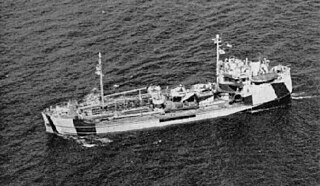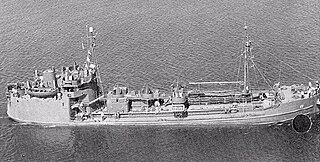USS Petaluma may refer to:
- USS Petaluma (AOG-69), was a gasoline tanker launched in 1945, renamed Transpet and eventually acquired by British-American Oil
- USNS Petaluma (T-AOG-79), was a gasoline tanker launched in 1945 as MT Racoon Bend
USS Petaluma may refer to:
Four ships of the United States Navy have been named USS or USNS Susquehanna, for the Susquehanna River which rises in Lake Otsego in central New York and flows across Pennsylvania and the northeastern corner of Maryland into the Chesapeake Bay, which is the flooded estuary of that river.
USS Mattabesett or Mattabesset may refer to:
USS Nanticoke may refer to:
USS Piscataqua may refer to:
USS Aroostook has been the name of three ships of the United States Navy.
USS Pinnebog (AOG–58) was a Patapsco-class gasoline tanker acquired by the U.S. Navy for the dangerous task of transporting gasoline to warships in the fleet, and to remote Navy stations.

USS Sheepscot (AOG-24) was a Mettawee-class gasoline tanker acquired by the U.S. Navy for the dangerous task of transporting gasoline to warships in the fleet, and to remote Navy stations.

USS Calamus (AOG-25) was a Mettawee-class gasoline tanker acquired by the U.S. Navy for the dangerous task of transporting gasoline to warships in the fleet, and to remote Navy stations.
USS Chiwaukum (AOG-26) was a Mettawee-class gasoline tanker acquired by the U.S. Navy for the dangerous task of transporting gasoline to warships in the fleet, and to remote Navy stations.
USS Hiwassee (AOG-29) was a Mettawee-class gasoline tanker acquired by the U.S. Navy for the dangerous task of transporting gasoline to warships in the fleet, and to remote Navy stations.

USS Ponchatoula (AOG-38) was a Mettawee-class gasoline tanker acquired by the U.S. Navy for the dangerous task of transporting gasoline to warships in the fleet, and to remote Navy stations.
USS Wakulla is a name used more than once by the United States Navy:
USS Yacona (AOG-45) was a Mettawee-class gasoline tanker acquired by the U.S. Navy for the dangerous task of transporting gasoline to warships in the fleet, and to remote Navy stations.

The Mettawee-class gasoline tanker was a class of small gasoline tankers based on the Maritime Commission standard T1-M-A2 hull that served in World War II. The ships were completed between 1943 and 1945. Despite being charged with the dangerous task of carrying a highly volatile cargo into battle, none of the Mettawee-class tankers were destroyed, but the USS Sheepscot capsized near Iwo Jima on 6 June 1945.
MS Transpet was a tanker of United States and Panamanian registry. Laid down as MV Avoca and acquired by the Maritime Commission (MARCOM) on a loan charter basis and renamed USS Petaluma (AOG-69), she was to be a type T1 Klickitat-class gasoline tanker built for the US Navy during World War II. She was named after the Petaluma River, in California. Petaluma (AOG-69) was never commissioned into the US Navy.

The St. Johns River Shipbuilding Company was created in Jacksonville, Florida, during World War II to build Liberty ships.

This article incorporates text from the public domain Dictionary of American Naval Fighting Ships.

The T1 tanker or T1 are a class of sea worthy small tanker ships used to transport fuel oil before and during World War II, Korean War and Vietnam War. The T1 tanker classification is still in use today. T1 tankers are about 200 to 250 feet in length and are able to sustain a top speed of about 12 knots. The hull designation AO is used by the US Navy to denote the ship is a T1 oil tanker and AOG that the T1 is a gasoline tanker. The small size allows the T1 to enter just about any sea port or to anchor around a small island, this was very useful during the Pacific War. The T1 tanker can carry about 48,000 to 280,000 bbls. Some T1 tankers were used to transport goods other than oil, a few were used for black oil-crude oil, diesel, chemicals and rarely bulk cargo like grain. T1 tankers are also called liquid cargo carriers. The T1 tanker has about a 6,000 to 35,000 deadweight tonnage (DWT) of cargo. The small size also gives the ships short turn around time for repair, cleaning, loading and unloading. A T1 tanker carrying dirty cargo, like crude oil needs a few weeks of labor to clean before carrying clean cargo. Most T1 ships during World War II were named after major oil fields. T1 tankers are operated by the US Navy, War Shipping Administration and United States Maritime Commission. Some T1s were loaned to England in the Lend-Lease program for World War II, after the war most were returned to the US. After World War II many of the T1 ships were sold to for civilian use. Each T1 had emergency life rafts on the boat deck. The ships had cargo booms and piping to load and unload fuel. During war time the T1 are armed for protection with deck guns. A typical ship may have one single 3"/50 dual purpose gun, two 40 mm guns and three single Oerlikon 20 mm cannon. A T1 at war time normally had a crew of 38 and up to 130. If operating as a United States Merchant Marine ship, the crew would be a mix of civilian Merchant Marines and United States Navy Armed Guards to man the guns.
USS Nodaway may refer to:
MVLouden was acquired by the Maritime Commission (MARCOM) on a loan charter basis and renamed USS Piscataqua (AOG-70), she was to be a type T1 Klickitat-class gasoline tanker built for the US Navy during World War II. She was named after the Piscataqua River, between New Hampshire and Maine. Piscataqua (AOG-70) was never commissioned into the US Navy.